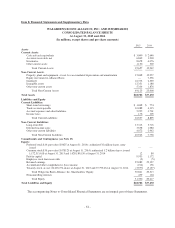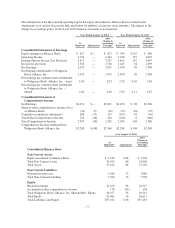Walgreens 2015 Annual Report Download - page 73
Download and view the complete annual report
Please find page 73 of the 2015 Walgreens annual report below. You can navigate through the pages in the report by either clicking on the pages listed below, or by using the keyword search tool below to find specific information within the annual report.
The Second Step Transaction resulted in the Company acquiring various equity method investments held by
Alliance Boots. These newly acquired investments are included together with the previous equity investments of
the Company within other non-current assets on the Consolidated Balance Sheets. See Note 6, Equity Method
Investments for further information relating to the Company’s equity method investments.
Investments
The Company’s investments consist principally of corporate debt, other debt securities, and equity securities of
publicly-traded companies.
The Company classifies its investments in securities at the time of purchase as held-to-maturity or available-for-
sale, and re-evaluates such classifications on a quarterly basis. Held-to-maturity investments consist of debt
securities that the Company has the intent and ability to retain until maturity. These securities are recorded at
cost, adjusted for the amortization of premiums and discounts, which approximates fair value. Available-for-sale
debt and equity securities are recorded at fair value. Unrealized holding gains and losses on available-for-sale
investments are excluded from earnings and are reported as a separate component of shareholders’ equity until
realized. Realized gains and losses of available-for-sale investments are included in the Consolidated Statement
of Earnings.
The Company evaluates investments held for other-than-temporary impairment. Such evaluation involves a
variety of considerations, including assessments of the risks and uncertainties associated with general economic
conditions and distinct conditions affecting specific issuers. Factors considered by the Company include (i) the
length of time and the extent to which the fair value has been below cost; (ii) the financial condition, credit
worthiness, and near-term prospects of the issuer; (iii) the length of time to maturity; (iv) future economic
conditions and market forecasts; (v) the Company’s intent and ability to retain its investment for a period of time
sufficient to allow for recovery of market value; and (vi) an assessment of whether it is more likely than not that
the Company will be required to sell its investment before recovery of market value.
Property, Plant and Equipment
Depreciation is provided on a straight-line basis over the estimated useful lives of owned assets. Estimated useful
lives range from 20 years for land improvements, 13 to 50 for buildings and building improvements and 3 to 20
for fixtures, plant and equipment. Leasehold improvements, equipment under capital lease and capital lease
properties are amortized over their respective estimate of useful life or over the term of the lease, whichever is
shorter. Major repairs, which extend the useful life of an asset, are capitalized; routine maintenance and repairs
are charged against earnings. The majority of the Company’s fixtures and equipment uses the composite method
of depreciation. Therefore, gains and losses on retirement or other disposition of such assets are included in
earnings only when an operating location is closed, completely remodeled or impaired. Property, plant and
equipment consists of (in millions):
2015 2014
Land and land improvements $ 3,687 $ 3,418
Buildings and building improvements 7,705 6,901
Fixtures, plant and equipment 8,904 7,559
Capitalized system development costs and software 1,491 688
Capital lease properties 821 530
22,608 19,096
Less: accumulated depreciation and amortization 7,540 6,839
Balance at end of year $15,068 $12,257
Depreciation expense for property, plant and equipment was $1.3 billion in fiscal 2015, $923 million in fiscal
2014 and $894 million in fiscal 2013.
-69-
























